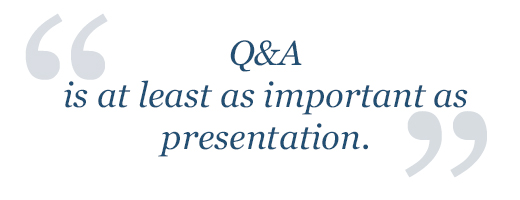You've delivered a compelling presentation – on message, well-supported, delivered with power, pacing, and poise. The experts and regulators around you appear receptive, some even convinced. But decisions have not yet been made. To reach agreement on a path for advancing your program, you still must navigate the Q&A period – an unstructured and sometimes adversarial exchange that likely has cost you some sleep. After all, questionable answers can blunt the mostly finely honed power points. Your pulse begins racing as the first query is posed. You have entered the risk zone.
This realm of interrogative risk lurks behind every meeting with health authorities, ranging from brief teleconferences to longer face-to-face consultations to full day FDA Advisory Committees or the corresponding approval hearings overseas. At times the risk zone is front and center, as regulators sometimes ask sponsors to dispense with formal presentations and proceed directly to discussion. Such requests can even be made at the last minute as your team is loading a polished slide deck you've rehearsed over and over. Suddenly, Q&A must stand, or fall, on its own.
There's no question about it: whatever the setting or duration, Q&A is at least as important as the presentation. This prominence reflects their similarities as well as apparent differences. Prepared opening statements and elicited replies target an identical goal: persuasion. Both aim to help influential but not always fully informed regulators (a CHMP challenge) understand, accept, and endorse action on your proposals.
But their differences can affect the way audiences respond. While impatient regulators may tap their fingers during a polished presentation, they typically lean forward when posing questions, which focus on what they want to hear, not what a sponsor wants to tell them. Moreover, because the best Q&A appears unrehearsed, responses may sound more authentic and less like slickly packaged talking points. But these differences are only superficial. Strategic presentations are designed around audience concerns and, for some meeting types, crafted to elicit positive answers to the questions sponsors pose themselves ("Does the division agree…?"). But Q&A is no less planned and rehearsed than presentations; indeed, the appearance of spontaneity in effective responses requires extensive practice.

To help teams convert the risk zone into one of reward, we recommend they mind their P's and Q's by focusing in equal measure on the Four Ps of Q&A:
Q&A, presentations, and briefing material all should start with a thorough analysis of the questions and concerns regulators may have. What aspects of your program are most likely to worry them, particularly in a period of increasing caution? How might a competitor interpret your data differently? What have you had to work hardest to explain to your management? Fresh pairs of eyes can help a team step outside its assumptions to see how very differently data can look from alternative points of view.
Thorough planning can identify 90 percent of the questions you will be asked. On quiz shows, it is cheating to know the questions in advance; in pharma meetings, it is professionalism. Some questions you will decide to address proactively in your briefing material and presentation. It is usually best to raise core concerns yourself, so you can pose them in the proper terms and provide the appropriate context. In so doing, you not only gain in transparency but rob potential questioners of the drama of raising provocative points.
We recommend teams create a MIRS Table (message-issue-response-support) to map the rhetorical landscape. The MIRS Table helps structure and maintain consistency among briefing documents, presentations, and Q&A. MIRS methodology also prevents teams from becoming so wedded to their own messages they are reluctant, or unable, to see issues that may undermine them.
Although answers must never sound packaged, they need to be carefully prepared and rehearsed. Decide who in your team is best suited to design and who to deliver (they often are different!) answers to the core questions you've identified. Agree on the elements of an effective answer and start developing written draft responses.
As you review draft responses, determine which answers require visuals and which work best without them. Plan to keep slides as a fallback; identify first-line oral answers that may suffice. (Especially in AdComms, the more unnecessary data you display, the more opportunity there is for fishing expeditions.) Keep a question book that your designated respondents can review before practice sessions and update after they hear what answers work and which ones raise more questions. Periodically compare the book with your MIRS table to ensure consistency and completeness. Update both as needed.
There is an art to sounding natural. The only way to acquire it is through practice and training. Learn techniques to manage performance anxiety so you can focus more on the substance of a question than the setting in which it is posed. It helps to remember that your goal is to convey competence and confidence, not style and polish. Stumbles can lend authenticity if managed well, so don't let them throw you.
Don't assume an issue is settled because it was addressed in the Briefing Document or opening presentation. Practice fielding questions about your answers without depending on either source. And work on probing the questioner to understand his or her real concerns, especially when previous explanations have not been satisfactory. If you're bringing outside experts with you to a meeting, don't just enter their names next to issues in your Question Book. Make absolutely sure you practice with them as well so you know what they will say – and how they will say it.
Although pharma meetings are ultimately about science, they involve many feelings, beliefs, and values. Since Q&A can sometimes grow heated, be sure to practice techniques for managing hostile questions in all their forms. Similarly, practice managing multipart questions and vague ones, both of which may invite you to create your own trouble.

Finally, at the meeting itself, use rhetorical and nonverbal techniques to manage the flow of the Q&A session. Such management begins with your presentation, which may invite questions covertly (by leaving some points unspoken) or overtly (by concluding with questions for agreement in meetings where that is appropriate). End your presentation strongly – not with a mild "Are there any questions?" but with a definitive "Now we'd like to discuss the questions you have."
Each time you take a question, pause for a few seconds after it is asked while maintaining eye focus with the questioner. That time can demonstrate thoughtfulness, which is part of the persona you want to convey. Moreover, silence can invite questioners to elaborate or rephrase their query, buying time for you to frame your message and support.
Hold that eye focus as you begin your response for about the time it takes you to utter a phrase; wait another moment, then shift your focus to another person. Never end a reply looking at the same person who asked it unless you truly want to play back and forth ping pong. Additionally, when you end a calm response to a hostile questioner by looking elsewhere, you invite sympathetic audience members to intervene by posing their own query.
As much as possible, use phrases that help listeners know that you respect their concerns. So, for instance, don't defend against adverse event questions. Instead, highlight a shared concern about patient safety. (Not "No, we have no absolutely no such toxicity" but rather, "In view of the age of the patients who will take this drug, we were particularly concerned to ensure there was no effect on growth plates. So we ran X, Y, and Z analyses, which showed…") Such language figuratively places you side-by-side with the questioner, not nose-to-nose. Similarly, you might tell a dubious questioner that you were also initially puzzled by a piece of outlying data but then explain how you have accounted for its appearance and resolved any issues it may have suggested. Showing such respect can maintain a spirit of honest inquiry by suggesting you understand your questioner's perspective even if you initially reached different conclusions. When teams give careful attention to these Four Ps, they take advantage of Q&A as a potent forum for removing any doubt that their messages are thoughtful and well-considered. Q&A is not the end of a presentation. It's a new critical and interactive dialogue that requires and rewards its own preparation.





